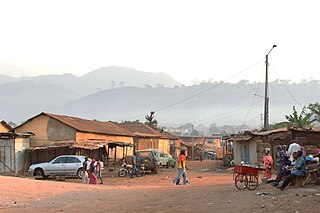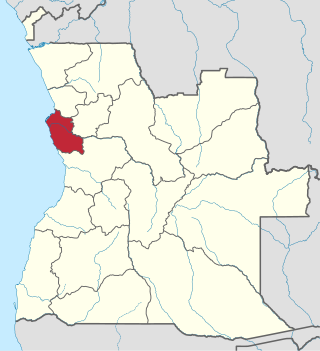
Angola, officially the Republic of Angola, is a country on the west-central coast of Southern Africa. It is the second-largest Lusophone (Portuguese-speaking) country in both total area and population, and is the seventh-largest country in Africa. It is bordered by Namibia to the south, the Democratic Republic of the Congo to the north, Zambia to the east, and the Atlantic Ocean to the west. Angola has an exclave province, the province of Cabinda, that borders the Republic of the Congo and the Democratic Republic of the Congo. The capital and most populous city is Luanda.

The foreign relations of Angola are based on Angola's strong support of U.S. foreign policy as the Angolan economy is dependent on U.S. foreign aid. From 1975 to 1989, Angola was aligned with the Eastern bloc, in particular the Soviet Union, Libya, and Cuba. Since then, it has focused on improving relationships with Western countries, cultivating links with other Portuguese-speaking countries, and asserting its own national interests in Central Africa through military and diplomatic intervention. In 1993, it established formal diplomatic relations with the United States. It has entered the Southern African Development Community as a vehicle for improving ties with its largely Anglophone neighbors to the south. Zimbabwe and Namibia joined Angola in its military intervention in the Democratic Republic of the Congo, where Angolan troops remain in support of the Joseph Kabila government. It also has intervened in the Republic of the Congo (Brazzaville) in support of Denis Sassou-Nguesso in the civil war.


Man is a city in western Ivory Coast. It is the seat of both Montagnes District and Tonkpi Region. It is also a commune and the seat of and a sub-prefecture of Man Department. In the 2014 census, the city had a population of 149,041, making it the eighth-largest city in the country.

Luanda is a province of Angola. It covers an area of 18,835 km2, and had a population of 6,945,386 at the Census of 16 May 2014. The latest official estimate is 8,247,688.

Lunda Sul is a province of Angola. It has an area of 77,637 km² and a 2014 census population of 537,587. Saurimo is the provincial capital.

The Angolan Civil War was a civil war in Angola, beginning in 1975 and continuing, with interludes, until 2002. The war began immediately after Angola became independent from Portugal in November 1975. It was a power struggle between two former anti-colonial guerrilla movements, the communist People's Movement for the Liberation of Angola (MPLA) and the anti-communist National Union for the Total Independence of Angola (UNITA).
Baster is a French band from Réunion, which founded in 1983. They perform sega, maloya and reggae. Their music has been described as electric maloya. They are one of the most popular maloya groups and perform a poetic and lyrical form of the genre.

The Cuban intervention in Angola began on 5 November 1975, when Cuba sent combat troops in support of the communist-aligned People's Movement for the Liberation of Angola (MPLA) against the pro-western National Union for the Total Independence of Angola (UNITA) and National Liberation Front of Angola (FNLA). The intervention came after the outbreak of the Angolan Civil War, which occurred after the former Portuguese colony was granted independence after the Angolan War of Independence. The civil war quickly became a proxy war between the Eastern Bloc led by the Soviet Union and the Western Bloc led by the United States. South Africa and the United States backed UNITA and the FNLA, while communist nations backed the MPLA.

Loango-Angola is the name for the possessions of the Dutch West India Company in contemporary Angola and the Republic of the Congo. Notably, the name refers to the colony that was captured from the Portuguese between 1641 and 1648. Due to the distance between Luanda and Elmina, the capital of the Dutch Gold Coast, a separate administration for the southern districts of Africa was established at Luanda during the period of the Dutch occupation.
Safir Hotels & Resorts is a Kuwaiti-owned luxury hotel chain in the Arabic world. Clientele includes the sister of the Emir of Kuwait who stayed in the hotel's $3000 a month apartments.
Grand Hotel Cirta or Hotel Cirta is a hotel in Constantine, Algeria, located in a white colonial building at 1 Avenue Rahmani Achour, on the edge of Place des Martyrs. The hotel is the property of the Societe de l'Hotel Cirta, owned by Mohand Tiar, an Algerian businessman and philanthropist.
Ouirgane is a small town and rural commune in Al Haouz Province of the Marrakesh-Tensift-El Haouz region of Morocco. At the time of the 2004 census, the commune had a total population of 6916 people living in 1281 households. It is a Berber village.
The following is a timeline of the history of the city of Luanda, Angola.
The following is a timeline of the history of the city of Cotonou, Benin.

Biyaadhoo or Biyadhoo is a circular ten-acre resort-island in South Malé Atoll in the administrative division Kaafu Atoll of the Maldives. The island is located 18 miles south of Malé International Airport. It is located 0.62 miles from the island of Makunufushi, and only 330 yards from another resort-island, Villivaru. Both Biyaadhoo- and Villivaru islands are owned and managed by the Taj group from India. It is mostly made up by the Biyadhoo Island Resort, but remains a densely vegetated and forested island. The rich soil allows the cultivation of various fruits and vegetables, e.g. numerous coconut-, banana-, and mango trees grow on the island. Experts here have also been employed in growing vegetables hydroponically, some of the vegetables grown on the island includes tomatoes, cabbage, and cucumbers used by the resort in preparation of various buffets. There is one resort, a restaurant, spa, and one bar located on the island, all which are parts of the resort. There is also evening entertainment for guests several times aweek.










